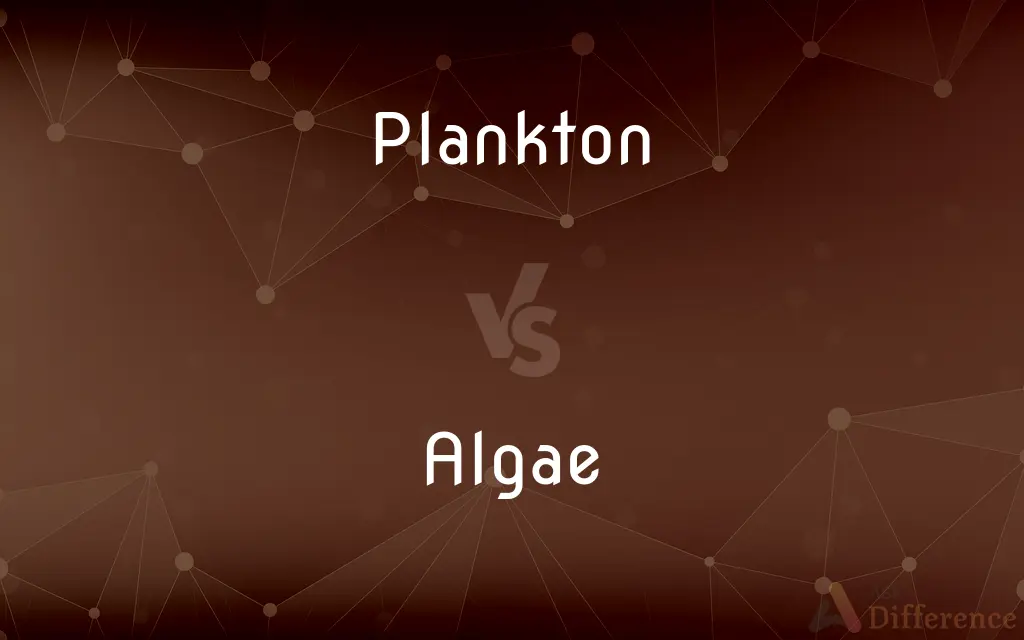Plankton vs. Algae — What's the Difference?
By Maham Liaqat & Urooj Arif — Updated on April 18, 2024
Plankton are diverse organisms, both microscopic and macroscopic, drifting in water bodies, whereas algae are primarily photosynthetic organisms, ranging from unicellular to multicellular forms.

Difference Between Plankton and Algae
Table of Contents
ADVERTISEMENT
Key Differences
Plankton encompasses a wide range of drifting organisms in aquatic environments, including both plants and animals. Whereas algae refer specifically to photosynthetic organisms that can be unicellular, like phytoplankton, or multicellular, like seaweed.
Plankton can be broadly classified into zooplankton (animal plankton) and phytoplankton (plant-like plankton that includes algae). On the other hand, algae are always photosynthetic and primarily serve as the base of the aquatic food web.
Plankton are ecologically crucial as they are primary producers and food sources within aquatic food chains. Conversely, algae, particularly phytoplankton, contribute significantly to oxygen production and carbon dioxide absorption in marine environments.
Algae can exist independently in various aquatic and moist terrestrial environments, growing on rocks, sea floors, and even on trees. Whereas plankton are inherently drifters, unable to swim against currents and thus are found throughout the water column.
The size of plankton can range from microscopic, like single-celled algae, to macroscopic forms, such as jellyfish. In contrast, algae range from microscopic forms to large seaweeds, like kelp, which can grow several meters in length.
ADVERTISEMENT
Comparison Chart
Definition
Diverse organisms drifting in water
Photosynthetic organisms, unicellular or multicellular
Types
Includes zooplankton and phytoplankton
Includes seaweeds, diatoms, green algae
Mobility
Drift with water currents, cannot swim
Some forms are sessile, others float in water
Role in ecosystem
Primary producers, food source
Produce oxygen, base of aquatic food webs
Size
Ranges from microscopic to macroscopic
From microscopic cells to large seaweeds
Compare with Definitions
Plankton
Drifting organisms in aquatic environments, unable to swim against currents.
Plankton include both microscopic algae and large organisms like jellyfish.
Algae
Grow in diverse environments, from oceans to damp tree trunks.
Green algae can often be seen on the sides of trees after rain.
Plankton
Serve as a crucial part of the aquatic food chain.
Small fish and whale sharks feed extensively on plankton.
Algae
Can be unicellular or form large multicellular structures like seaweed.
Kelp forests are dense groupings of large algae.
Plankton
Include both plant-like (phytoplankton) and animal-like (zooplankton) forms.
Phytoplankton are responsible for much of the Earth’s oxygen.
Algae
Used in various industries, from food to biofuel production.
Algae are used to produce dietary supplements and biofuels.
Plankton
Essential for the marine and freshwater ecosystems' health.
The presence of plankton indicates healthy aquatic conditions.
Algae
Photosynthetic organisms found in both freshwater and marine environments.
Algae include organisms like spirulina and giant kelp.
Plankton
Found throughout water columns in oceans, seas, and freshwater.
Plankton can be found from surface waters to deep sea levels.
Algae
Base of the food web, providing energy and oxygen to marine life.
Algae photosynthesis releases oxygen needed by marine animals.
Plankton
Plankton are the diverse collection of organisms found in water (or air) that are unable to propel themselves against a current (or wind). The individual organisms constituting plankton are called plankters.
Algae
Algae (; singular alga ) is an informal term for a large and diverse group of photosynthetic eukaryotic organisms. It is a polyphyletic grouping that includes species from multiple distinct clades.
Plankton
The small or microscopic organisms that drift or swim weakly in a body of water, including bacteria, diatoms, jellyfish, and various larvae. Plankton is an important food source for fish and other larger organisms.
Algae
Any of numerous photosynthetic organisms of aquatic or moist habitats, ranging in size from single-celled diatoms to large seaweeds such as kelp, and characterized by a lack of complex organs and tissues. Once classified within the plant kingdom, the algae are now considered to include several unrelated groups belonging to different kingdoms.
Plankton
(uncountable) Organisms, especially small and microscopic ones, that drift in water.
Algae
Algal organisms viewed collectively or as a mass; algal growth.
Plankton
(uncountable) A plankter, any single organism that drifts in water.
Algae
(countable) A particular kind of algae.
Plankton
All the animals and plants, taken collectively, which live at or near the surface of salt or fresh waters.
Algae
Plural of alga.
Plankton
The aggregate of small plant and animal organisms that float or drift in great numbers in fresh or salt water
Algae
Primitive chlorophyll-containing mainly aquatic eukaryotic organisms lacking true stems and roots and leaves
Common Curiosities
Can all plankton photosynthesize?
No, only phytoplankton can photosynthesize; zooplankton are consumers.
What is plankton?
Plankton are organisms that drift in water bodies, unable to swim against currents.
What are algae?
Algae are photosynthetic organisms that may be unicellular or multicellular.
What types of environments do algae inhabit?
Algae can be found in a wide range of environments, including oceans, freshwater, and damp terrestrial locations.
What ecological roles do algae play?
Algae produce oxygen and form the base of many aquatic food webs.
Can algae survive outside of water?
Some algae can survive in moist environments but generally require some water to thrive.
What are some commercial uses of algae?
Algae are used in food, cosmetics, and biofuel industries.
How do plankton contribute to the ecosystem?
Plankton are primary producers and a vital part of aquatic food chains.
Are all algae considered plankton?
No, only the floating, photosynthetic forms of algae are considered as part of phytoplankton.
Why are plankton important to marine life?
They serve as the initial food source in marine and freshwater ecosystems.
How do the sizes of plankton and algae compare?
Both can be microscopic, but algae can also grow into large structures like seaweeds.
How do plankton and algae differ in mobility?
Plankton drift with currents, while some algae can attach to surfaces or float freely.
How does the diversity of plankton affect aquatic ecosystems?
Their diversity ensures a balanced ecosystem with varied dietary sources for different marine animals.
What is the significance of phytoplankton in algae classification?
Phytoplankton are the photosynthetic part of the plankton community and include many types of algae.
What makes zooplankton different from other types of plankton?
Zooplankton are the animal part of the plankton community and feed on other microscopic organisms.
Share Your Discovery

Previous Comparison
Offence vs. Crime
Next Comparison
Political vs. SocialAuthor Spotlight
Written by
Maham LiaqatCo-written by
Urooj ArifUrooj is a skilled content writer at Ask Difference, known for her exceptional ability to simplify complex topics into engaging and informative content. With a passion for research and a flair for clear, concise writing, she consistently delivers articles that resonate with our diverse audience.














































